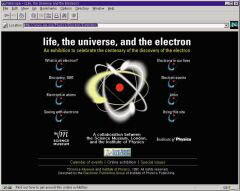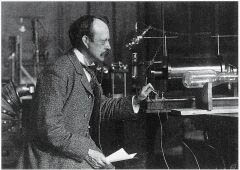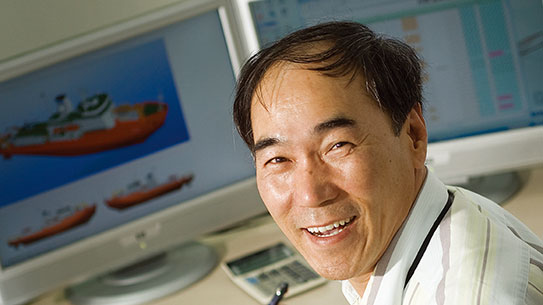물질의 근본 구성입자 중 하나이자 20세기 과학문명의 핵심인 전자. 올해로 전자가 발견된지 1백년이 지났지만 여전히 풀리지 않는 의문점이 남아 있다. 이번호에 소개하는 사이트는 전자발견 1백주년을 기념하는 온라인 전시관이라 할 수 있다. "삶, 우주, 그리고 전자"(http://www.iop.org/Physics/Electron/Exhibition/)라는 제목을 가진 이 사이트는 전자란 무엇인가?, 전자의 역사, 원자속의 전자, 각종 이벤트, 관련 자료 소개 등을 풍부하고 짜임새있게 제공하고 있다. 다음은 이 사이트의 내용중 "전자란 무엇인가?(What is an electron?)(http://www.iop.org/physics/Electron/Exhibition/section1/)부분이다.

전자와 그 특징
● 총알 같은 전자
전자의 질량은 9×${10}^{-31}$kg으로 양성자 질량의 2천분의 1이다 (또는 먼지 질량의 1조분의 1). 전자총의 총구에서 빠져나온 전자는 특정한 속도로 탄도를 그리며 움직인다. 전자는 정확히 1.6×${10}^{-19}$쿨롬의 전하량을 가지고 있다. 총신의 강선이 총알을 회전시키는 역할을 하듯이, 전자총도 잘하면 전자가 회전하도록 만들 수 있다.
전자의 반지름을 측정하려는 모든 시도는 실패했다. 단지 알 수 있는 것은 반지름이 10${10}^{-18}$m보다 작다는 것이다. 즉 전자의 반지름은 원자의 1억분의 1 정도로 작다. 이미 알려진 전자의 모든 특성들은 전자의 반지름을 0으로 가정할 때 잘 맞는다. 지금까지 알려진 바로는 전자는 구조를 갖고 있지 않다.
매우 당황스러운 사실은 어떻게 입자가 크기와 구조를 갖지 않을 수 있으며, 이런 입자가 질량을 갖고 회전운동을 할 수 있느냐는 것이다. 이러한 의문점에 대해 현재는 알 수 없으나, 과학자들은 이를 밝히려는 실험을 계속하고 있다.
● 파동과 같은 전자
전자에만 한정짓거나 전자운동의 자유도에만 국한한다면 전자는 마치 파동처럼 행동한다. 수소원자의 경우를 생각해보자. 전자는 원자핵 주위를 선회한다. 수소의 경우 원자핵은 1개의 양성자다. 전자는 명확하게 원궤도를 회전하기보다 양성자 주위의 모든 위치에 거의 동시에 나타난다. 마치 파동처럼 행동하는 것이다.
만약 두 개의 원자를 가깝게 근접시킬 경우 각각의 전자구름들이 결합할 수도 있다. 전자구름이 결합하면 분자가 생성된다. 금속의 경우 파동으로 본 전자는 금속의 전 영역에 퍼진다.

표준모델에서의 전자
물질의 구조를 알아내기 위해 물리학자들은 입자를 고에너지로 가속시키는 가속기를 사용한다. 가속된 입자들의 충돌은 매우 격렬해져 새로운 입자들이 튀어 나온다. 유럽 제네바 CERN(유럽 핵물리연구센터) 근처에는 세계 최고의 에너지를 갖는 전자-양전자 충돌기인 LEP가 있다. 미국 일리노이주의 페르미연구소(http://www.fnal.gov/pub/standard-model.html)에는 최고 에너지를 갖는 양성자-반양성자 충돌기가 있다.
이런 저런 장비를 사용해서 얻어낸 실험결과를 해석하기 위해서 물리학자들은 표준모델을 만들어냈다. 오늘날에는 각각 다른 여섯개의 쿼크가 있다고 여겨진다. 이들 사이에 작용하는 힘은 양자 색역학(QCD) 이론을 이용해 설명한다. 이들 쿼크를 여섯 개의 렙톤(전자와 중성미자를 포함하는 그룹)과 짝을 지으면 이들 사이에는 또 다른 힘이 작용한다.
빅뱅에서의 전자
과학자들은 우주의 시작이 빅뱅이 있었던 1백억 내지 2백억년 사이의 어느 때라고 여기고 있다. 우주가 공간과 시간을 갖자 마자 곧 빠른 속도로 팽창했고, 또한 냉각됐다. 몇 분의 1초 후에는 전자를 포함한 여러 입자와 이들 사이 힘이 우주를 만들었다. 그 때 원자도 생성되었고, 항성과 행성들이 태어났다.
존재하는 모든 것, 공간, 시간, 항성, 은하, 그리고 우리들까지도 빅뱅 당시로 거슬러 올라갈 수 있을 것이다. 빅뱅이론을 알려면 NASA(http://map.gsfc.nasa.gov/html/big_bang.html)를 찾아보는 것이 좋다.
고체에서의 전자
전자공학에서는 반도체라 불리는 특별한 물질이 필요하다. 이 물질의 특성은 전자에 따라 달라진다. 전류는 전자의 흐름에 의존한다. 금속은 자유롭게 움직이는 많은 전자를 포함하며, 이 전자의 흐름이 전류다. 반도체는 적은 양의 자유전자만을 가지고 있기 때문에 별도의 전자를 추가하느냐, 삭제하느냐에 따라 전기를 통할 수도 있고, 차단할 수도 있다.
원자구조 속에서의 전자
전자는 모든 것에 포함돼 있다. 유기체를 포함해 모든 물질은 수백, 수천 수억만개의 원자를 가지고 있다. 그리고 원자는 전자, 양성자, 그리고 또 다른 입자들로 이루어졌다. 전자는 원자가 다른 원자들과 결합하도록 하는 역할을 한다.
The electron and its properties
*The electron as a bullet
It has a mass of 9×${10}^{-31}$kg or 1 two thousandth of the mass of a proton (or one million millionth of the mass of a speck of dust). When the electron is shot out of the muzzle of an electron gun it emerges with a particular velocity and travels along a well defined trajectory. The electron carries a precise charge of 1.6×${10}^{-19}$ coulombs. By careful design, an electron gun can make the electrons spin - like the rifling inside the barrel of a gun can make bullets spin.
All attempts to measure the radius of the electron have failed! All we know is that the radius is less than ${10}^{-18}$m; that is, its radius is one hundred million times smaller than that of the atom. All the known properties of the electron are consistent with the assumption that its radius is zero. As far as we know, the electron has no structure.
What is puzzling is how a particle can have no size and no structure and yet can have a definite mass and behave as though it is spinning? We do not know the answers to these questions but scientists are working on experiments to find out.
The electron as a wave
Confine an electron, or constrict its freedom of movement and the bullet looks like a wave. Think of an atom - say hydrogen. The electron orbits the nucleus; in the case of hydrogen the nucleus is a single proton. Instead of a neat circular orbit the electron flies around the proton appearing at all points almost simultaneously. It behaves like a wave.
If we bring two atoms close together their electron clouds may merge. If the electron clouds merge we get a molecule. In metals the electron waves spread out over the whole volume of the material.
Electrons in the Standard Model
To find out about the structure of matter, physicists use machines to accelerate particles to high energies. When these particles collide, the collisions are violent enough to disturb exotic particles.
In Europe, LEP, at CERN near Geneva, is the highest-energy electron-positron collider in the world. In the United States, Fermilab in Illinois has the highest-energy proton-antiproton collider.
To understand the results of experiments using these and other machines, physicists have developed the Standard Model. Today they think there are six different quarks. The forces between them are described by a theory, quantum chromodynamics (QCD). Matching these quarks are six leptons (a group including the electron and neutrino). Several different forces operate between quarks and leptons.
Electrons in the Big Bang
Scientists think that our universe began sometime between 10 and 20 billion years ago, an event known as the Big Bang.
When the universe began so did space and time. The universe expanded very quickly. It also cooled. After a tiny fraction of a second, the universe consisted of several kinds of particles, including electrons, and the forces between them. In time, atoms were formed, and then stars and planets.
Everything that exists, space, time, stars, galaxies, and you, can be traced back to the Big Bang. Visit NASA for a guide to the Big Bang Theory.
Electrons in condensed matter
Electronics needs special materials called semiconductors. The properties of these materials depend on electrons.
Electric currents rely on the movement of electrons. Metals have lots of electrons which can move freely, and therefore metals conduct electricity. Semiconductors have only a few free electrons but it is possible to make them conduct or not by adding or removing electrons.
Electrons in atomic structures
Electrons hold the world together. All matter, including living things, is made up of millions of millions of millions of millions of atoms. In turn atoms contain electrons and other particles. The electrons enable atoms to join together into groups.

















